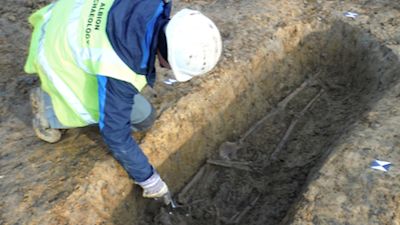The case of crucifixion unearthed in a quaint Cambridgeshire village

The first-ever example of a Roman crucifixion in the UK has been unearthed in a small Cambridgeshire village.
The discovery, which experts say is historically significant, was made during archaeological excavations carried out before a new housing development was built in Fenstanton near Cambridge.
Archaeologists uncovered five small cemeteries, where 40 adults and five children were buried. Inside one grave lay the remains of a man with a nail through his heel - a sign that he died by crucifixion.
Osteologist Corinne Duhig from Wolfson College, Cambridge, said: "The lucky combination of good preservation and the nail being left in the bone has allowed me to examine this almost unique example when so many thousands have been lost.
"This shows that the inhabitants of even this small settlement at the edge of empire could not avoid Rome's most barbaric punishment."
Only one previous example like this of crucifixion has been found worldwide, in Israel, although two possible instances have also been claimed in Italy and Egypt.
But experts say the Fenstanton example is the best preserved.
It is not the first time Cambridgeshire has unearthed such significant historical finds.
Preserved Bronze Age buildings and artefacts were discovered at Must Farm in Whittlesey
Pristine prehistoric occupation sites and burial monuments were uncovered in Needingworth Quarry
New Iron Age, Roman and Anglo-Saxon settlements emerged during the course of the recent A14 road improvement scheme around Cambridge
The Roman graves, now fully excavated, also included a number of archaeologically significant artefacts. However, the results of the whole excavation will be formally published when analysis of all the finds and evidence has been completed.
Speaking for Cambridgeshire County Council's Historic Environment Team, archaeologist Kasia Gdaniec said: "These cemeteries and the settlement that developed along the Roman road at Fenstanton are breaking new ground in archaeological research.
"Burial practices are many and varied in the Roman period and evidence of ante-or post-mortem mutilation is occasionally seen, but never crucifixion.
"We look forward to finding out more when the results are published. Hopefully, there will be a museum exhibit to showcase the remains soon, and we are working to arrange this."